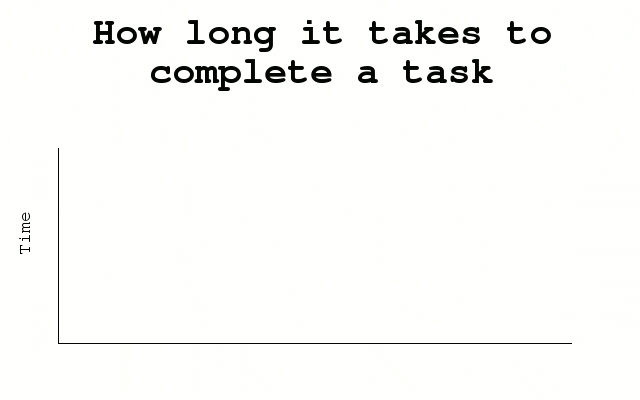Nobody likes inefficient meets where the minutes > value gained! It’s not a fun time for anybody involved! That’s what agile scrum meetings are for! The widespread adoption of agile methods helps accelerate software delivery, increase productivity, and improve alignment between IT and business departments. In fact, many companies who have adopted agile methods reaped the benefits of this technique as they experienced a 60% growth in revenue and profits. Today, we’ll walk you through how to conduct scrum agile meetings for your team’s next sprint. So, let’s get 🏃🏃🏃🏃
As this is a super important topic for me, I’ll be delving briefly into this subject, with a more in-depth analysis on Agile Scum’s to come!
In this article
What are agile scrum meetings?
Let’s start by breaking it down into these two words: agile and scrum. Initially, agile is a project management framework for technical teams wherein the goal is to see success in valued intervals rather than finishing a project in one single swoop.
Scrum falls under the agile framework. In agile scrum meetings, team members collaborate and tasks are distributed and accomplished in a given span of time called sprint planning timebox. That is to say that agile scrum meetings involve several other methods to ensure their effectiveness.
A scrum meeting’s defining feature is its scrum timebox style of finishing tasks. Team members meet and decide what needs to be done at the start of the week, and aim to finish everything in a span of two weeks before meeting again to discuss their progress, accomplishments, and other relevant topics.
What is a sprint backlog? Also known as PBI scrum, a sprint backlog is any task that relates to the accomplishment of a bigger picture or the final output of the whole project. That is to say that a PBI scrum is accomplished based on how it will affect the entirety of the project and does not necessarily need to be done according to when it’s added to the task list.
Before everyone jumps straight to their assigned roles, agile scrum meetings begin with sprint planning. You can say that sprint planning would be the longest meeting the team will have to go through as this involves intensive planning, strategizing, and task delegation to make sure all bases are covered and all requirements will be met during the two-week-long sprint.
After a productive two weeks, a sprint review will be conducted at the end of the sprint. During a sprint review meeting, the team will present their accomplished outputs during the sprint to gather feedback from other members, stakeholders, and even from the product owner. Constant communication is one of the important components of an agile scrum meeting, which is why the feedback during the sprint review is a crucial part of the communication and collaboration scheme.
The sprint does not simply end after the sprint review. A sprint retrospective is held between the members of the sprint team wherein they are given the time to discuss the whole sprint progress amongst themselves. From their own learnings to the stakeholders’ and product owners’ feedback, the sprint team takes this time to process everything, identify points for improvement, and decide on the next steps that they need to take.
Agile scrums that actually work!
What sets these meetings apart from the rest? For one, scrum meetings are effective in that it puts you through intense collaboration and teamwork on a daily basis without necessarily requiring long meetings.
Now that we’ve identified the sprint process step-by-step in an agile scrum meeting, let’s move on to learning how one is able to successfully accomplish tasks and contribute to the project’s progress. There are certain key points that one needs to identify to make agile scrum meetings worthwhile: scrum pillars, scrum timebox, and scrum questions.
Scrum pillars



In order to derive good results, one must observe the three pillars of scrum:
- Transparency: All information about the project’s progress, including challenges, pain points, and mistakes, must be laid bare for the whole team and stakeholders to see. Transparency is very important in ensuring the success of a project as it allows the whole team to quickly assess, overcome, and rectify the situation immediately. Agile scrum meetings and sprints have no room for delays.
- Inspection: Once again, the whole team is involved in the scrum inspection. Following transparency, the team adapts to the suggestions made by a client or stakeholder about the project after their evaluation and inspection. This is an important agile pillar you shouldn’t ignore because this is where you’ll know how to proceed.
- Adaptation: As mentioned above, the team should be able to adapt to any changes, recommendations, and suggestions by the client easily and quickly. This is what this agile pillar is all about. Moreover, adapting to these changes must reflect progress and growth. The project, even with the needed changes, should be steadily advancing instead of being stuck to a single point even with the constant changes being applied.
Scrum Timebox
Timeboxing or scrum timebox is the method of allotting a specific length of time to accomplish a task. For instance, sprints are enclosed in a two-week period, agile scrum meetings and sprint planning are set for a specific number of hours, and so are sprint reviews and retrospectives. Scrum timebox is a way for the team to manage their time wisely and meet deadlines on time.
Scrum questions
Your scrum questions serve as your guide to doing things right and walking in the right direction. Speculations will remain as speculations unless they are properly addressed as scrum questions and are answered to get results. Scrum questions can be anything from “what ifs” to the “hows” of making a product work or become successful.
All the agile scrum meeting templates and agendas you'll ever need!
Dive into your next retro or planning sesh with our library of agile scrum templates. We’ve included document types such as Jira, Confluence, Notion, Google Docs and Evernote.
Sprint Planning meeting template and agenda
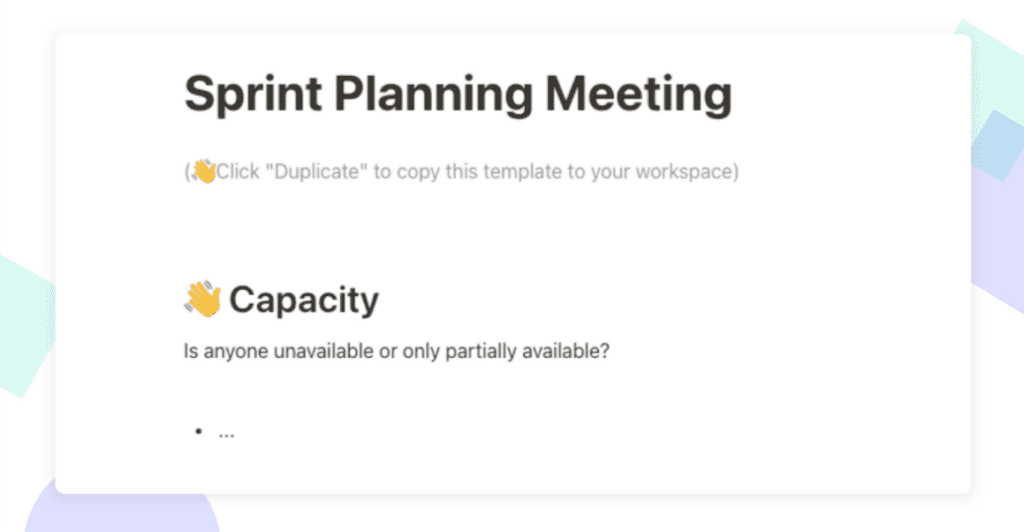
Having a sprint planning meeting template is incredibly helpful, most especially for teams who are new to agile scrum meetings. This is the first step to the whole process so the template lets you list down member names for attendance, agendas, goals, and delegated tasks. Your sprint planning meeting template can act like a guide that your team can constantly check if they’re feeling a bit lost or having problems with time management.
Do not hesitate to use scrum meeting templates especially if you are new to practicing the agile scrum framework. Even long-time professionals who adopted agile scrum meetings use templates to keep track of everything that happens for the whole duration of a project. These templates are also great methods for taking the minutes of a meeting, ensuring that all points are covered and that everyone gets to contribute and say their piece. Download the Sprint Retrospective meeting template and agenda in these document formats:
Google Docs
Jira
Confluence
Notion
Evernote
Daily stand-up meeting template and agenda
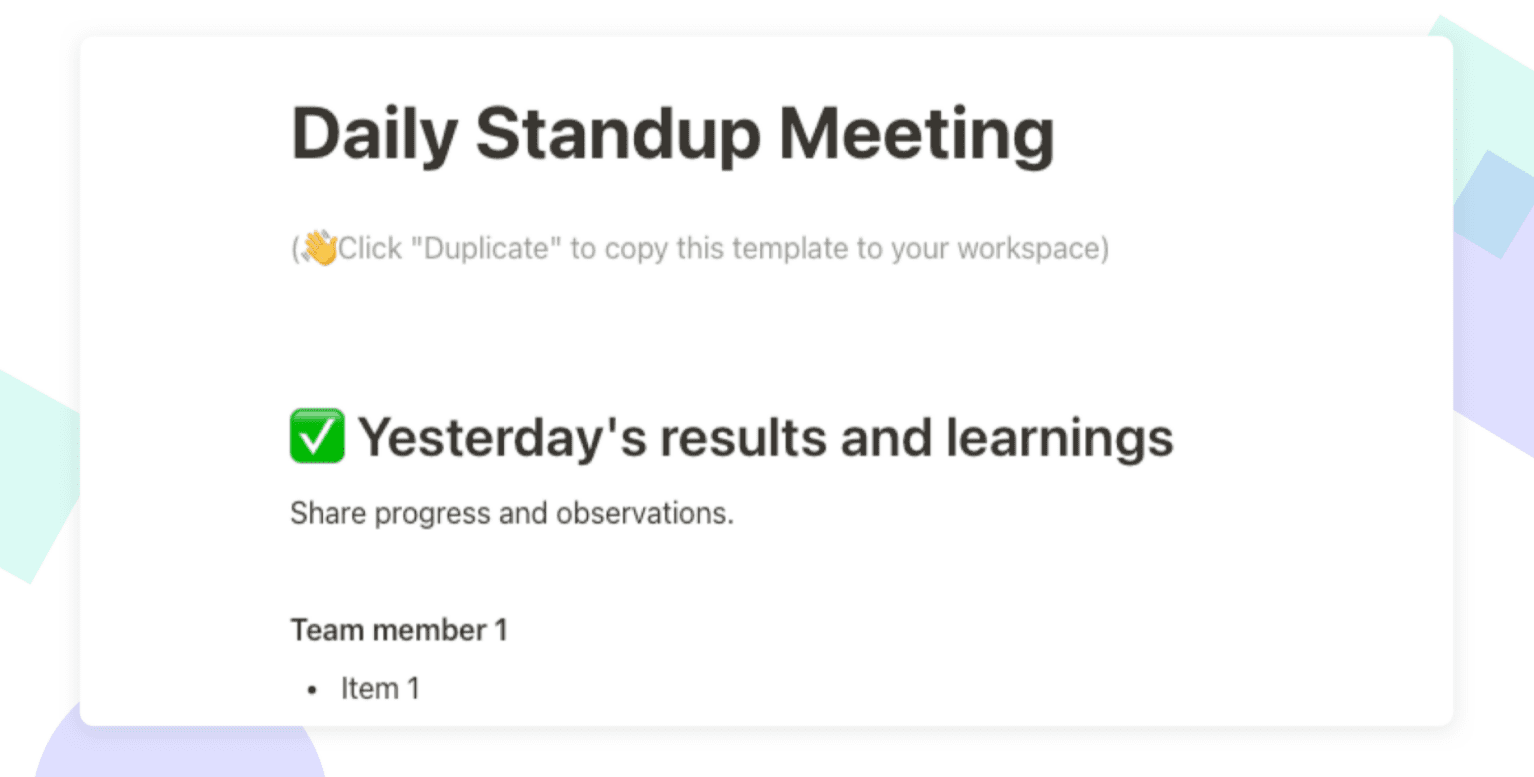
Like we have mentioned above, communication is essential in agile scrum meetings. Checking on your team members to see their progress and learn if they are encountering any roadblocks, is done during the daily stand-up meeting. You can also add in the different learnings from the project or scrum team members’ insights about possible designs, features, and bugs during this part of the meeting. Download the daily stand-up meeting template and agenda in these document formats:
Notion
Evernote
Google Docs
Jira
Confluence
Product Backlog Refinement and Inventory template
Having a meeting template that lists down daily tasks or to-do’s is extremely helpful in keeping the team on track. With a product backlog refinement and inventory template, you can properly see all the tasks needed to be done during the sprint. The team will also not lose sight of any changes in case new tasks are added in between the PBI scrum priority list. Download the product backlog refinement and inventory template here.
Sprint Review Meeting template and agenda
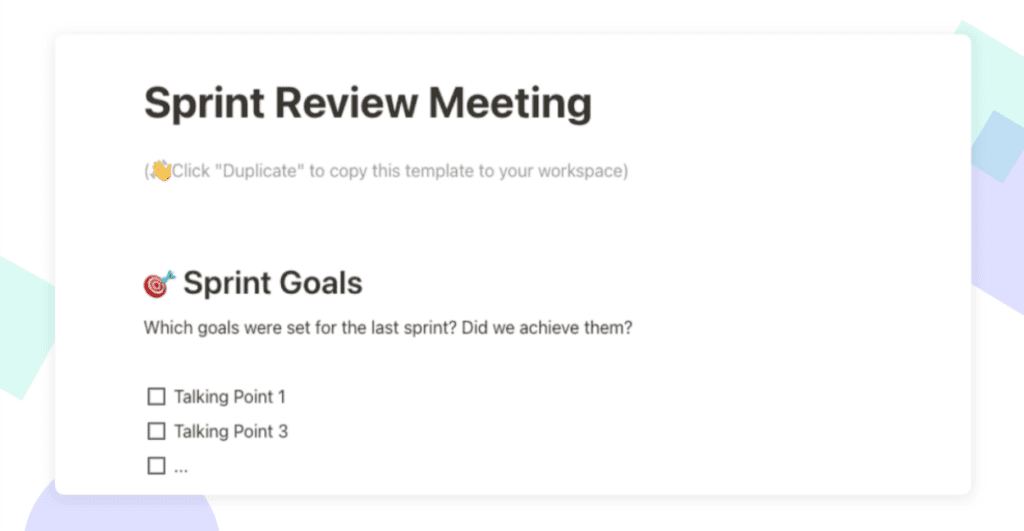
After presenting the progress of the project or product, expect to receive different feedback. Simply taking notes or committing the review to memory will not be enough and can cause you to miss other important points. A sprint review meeting template lets you organize the reviews and feedback given into talking points. This way, it will be easier to process all the information later on. Download the Sprint Review meeting template and agenda in these document formats:
Jira
Confluence
Notion
Evernote
Google Docs
Sprint Retrospective meeting template and agenda
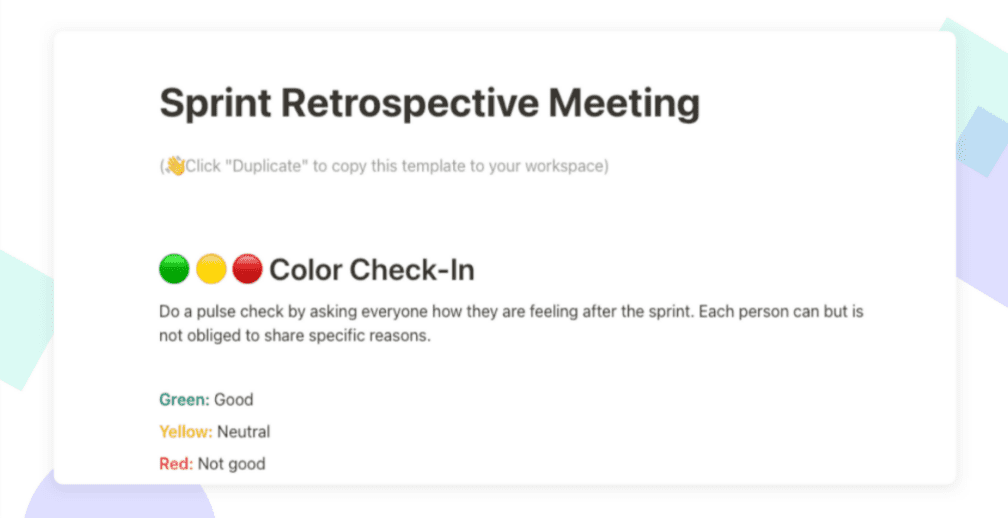
As the last and most important sprint meeting, retrospective meetings should be properly organized. All points of improvement, decision-making and next steps are decided during a sprint retrospective meeting. The sprint retrospective meeting template lets you label each key point into good, neutral, or bad, all of which help you identify which parts to focus on and what areas need cultivating for the success of the project.
This is really key, as a retrospective is designed to iteratively, improve the team’s output overall, by discussing what could be improved in the realization of our tasks in the next sprint, with concrete actions items. It’s not only about highlighting what could be improved, it is also about agreeing with the team on next steps to try/change in future Sprints.
Download the Sprint Retrospective meeting template and agenda in these document formats:
Notion
Evernote
Google Docs
Jira
Confluence
Agile scrum meetings are not for software developers only
I personally live by this Agile and Scrum bible! But like with every good process, it needs to be adapted to your particular needs and team! The framework is systematic but it is also flexible. Lots of different teams who are working on a project, whether big or small, can benefit from the very disciplined ways of the agile scrum framework.
Sprints can help team members practice proper time management while sprint inspections and retrospectives can keep all channels of communication open. The pillars of scrum are applicable to almost any team project as it also helps build trust among the members.
In short, we can say that agile scrum meetings work towards one goal: get the work done! 💪

